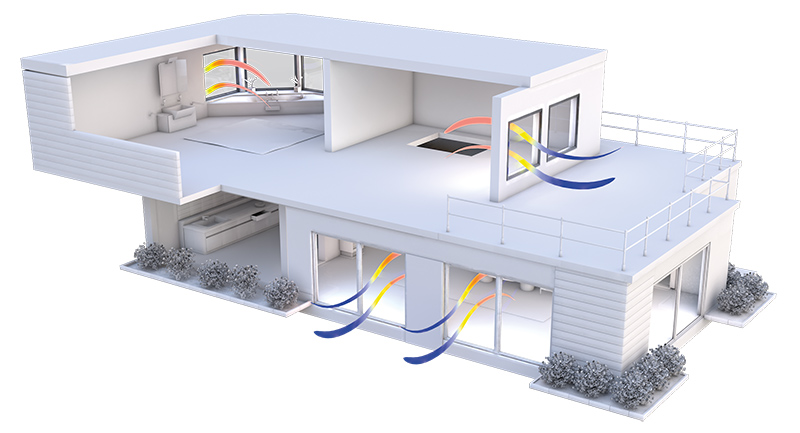VENTILATION SYSTEMS
Why do I need ventilation?
For all-round feel-good protection

Never again problems with pollen
Especially for people with pollen allergies, ventilation is always a challenge that involves a great deal of risk. With a ventilation system, this is no longer a problem either. Unwanted pollen is simply filtered out during the fresh air supply and only pollen-free air arrives in the building.
Long-term protection, also for the building
Good insulation is the order of the day in many buildings these days, whether they are new or renovated old. As nice as the warmth may be, this progress can harm both the building and its occupants, because there is no automatic exchange of fresh air. Moisture accumulates more quickly, which quickly leads to the formation of mould or structural damage. A ventilation system counteracts this.
Burglary protection
If you leave your home with the window open, it is sometimes your own fault in the event of a burglary. But if this is no longer necessary because the house can be ventilated by a ventilation system, whether at home or away, burglars are out of luck - and the residents can breathe easy at the same time.
Fresh air - all day long
On average, a person spends 80% of the day indoors. It is precisely during this large part of the day that fresh air must be guaranteed, because stale air makes people tired and even ill in the long run.
Heat and air at the same time
While it is best for the air to always enter your own four walls nice and fresh, the heat should of course not escape at the same time. Many ventilation systems work with heat recovery so that it is never necessary to freeze for fresh air.
Environmental friendliness
The heat recovery that some ventilation systems bring with them has another advantage: they promise lower energy consumption and CO2 emissions, and that in turn is good for the environment.
Quiet, even next to the main road
Finding sleep in residential buildings next to a busy road is always a challenge. If, on top of that, you want to ventilate on warm summer nights, the desire for sleep seems utopian - so you need a way to get fresh air without opening the windows to the noise of the street. Once again, this is a case for ventilation systems.
EnEV Directive and DIN 1946-6
Ventilation is no longer just an option.
Today, the installation of ventilation measures is considered mandatory in new buildings, because the Energy Saving Ordinance (EnEV) and DIN 1946-6 require in the currently valid version: "Buildings to be constructed must be designed in such a way that the minimum air exchange required for health and heating purposes is ensured".
Advantages of decentralised ventilation systems
Individual ventilation solution where it is needed

Space & planning
Decentralised ventilation systems can be used almost anywhere, and at any time. Even an old building can benefit from such a system and even where there is not enough space for a central ventilation system, the decentralised alternative fits easily and without time-consuming planning of the ventilation ducts.
Hybrid ventilation possible
A room-by-room separation or the targeted selection of supply and extract air systems enables user-related ventilation according to requirements. The amount of air required for air exchange can also be regulated according to need. Decentralised ventilation systems can be installed in individual rooms so that fresh air is available exactly where it is needed.
Hygiene
Many people are put off by the piping system in a central ventilation system. This must be maintained occasionally to ensure hygiene. Such maintenance is not necessary with decentralised ventilation units.
Price advantage
Price in particular is an important factor when it comes to deciding on the desired ventilation system. Because decentralised ventilation systems are only placed in individual rooms and no ventilation ducts have to be laid, they are the more cost-effective option.
The simple installation also saves on assembly costs.

